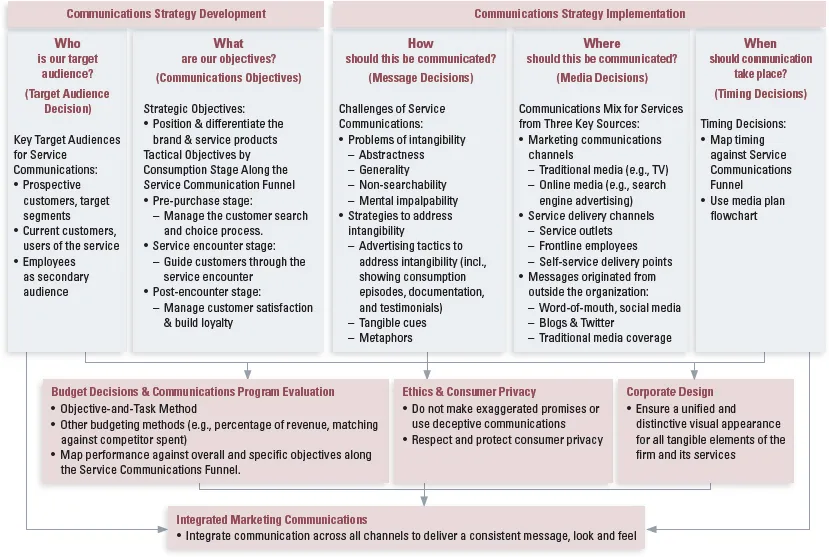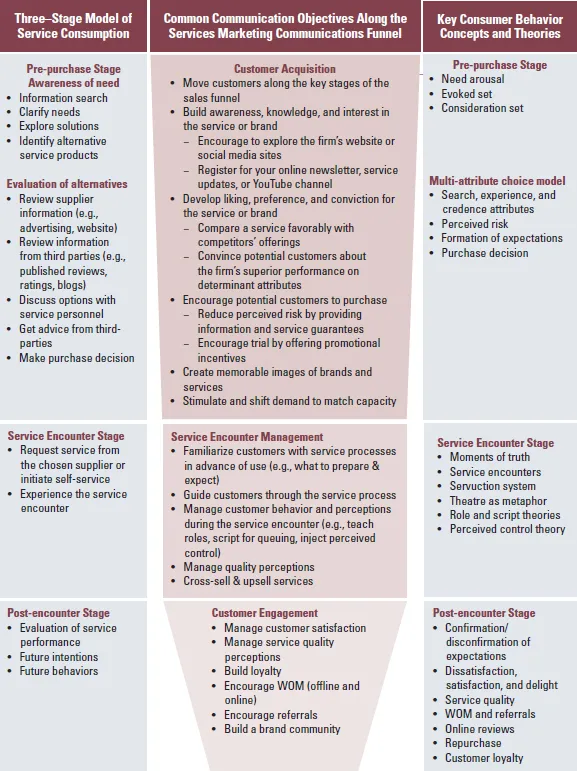![]()
VOLUME 5
Service Marketing Communications
Life is for one generation; a good name is forever.
Japanese proverb
Education costs money, but then so does ignorance.
Sir Claus Moser
British statistician
We don’t have a choice on whether we do social media; the question is how well we do it.
Erik Qualman
Author of Socialnomics
INTEGRATED SERVICE MARKETING COMMUNICATIONS1
Although communication is the most visible or audible form of marketing activities, its value is limited unless used intelligently in conjunction with other marketing efforts. According to an old marketing axiom, the fastest way to kill a poor product is to advertise it heavily. By the same token, an otherwise well-researched and well-planned marketing strategy is likely to fail if prospects are not aware of a service firm’s existence, what it has to offer, the value proposition of each of its products, and how to use them to their best advantage. Customers can be easily lured away by competitive offerings, if there is no proactive management and control on the firm’s identity. Marketing communications, in one form or another, are essential to a company’s success. This volume focuses on how to plan and design an effective marketing communication strategy for the services offered. Through communications, marketers explain and promote the value proposition their firm is offering.
Communications must be viewed more broadly than just as media advertising, public relations, social media, and professional salespeople. There are many other ways for a service business to communicate with current and prospective customers. Location and atmosphere of a service delivery facility, corporate design features, such as consistent use of colors and graphic elements, appearance and behavior of employees, design of a website, all these make a profound impression on customer’s mind that reinforces or contradicts the specific content of formal communication messages.
In the past few years, Internet and mobile apps have emerged as new and exciting opportunities for reaching prospects with previously unimaginable targeting and message specificity. All these media have to be effectively synchronized to attract new customers and to affirm the choice of existing customers, while educating them on how to proceed through a service process.
Developing an effective service marketing communications strategy starts with a good understanding of the service product and its prospective buyers. It is essential to understand target market segments and their exposure to different media, consumers’ awareness of the service product, their attitudes toward it, and how they can easily evaluate the products characteristics prior to purchase, and during and after consumption. Decisions include determining the content, structure and style of the message to be communicated, its manner of presentation, and the media most suited to reach the intended audience.
To integrate all these considerations, the Integrated Service Communications Model was developed as shown in Figure 1, which serves as the organizing framework for this volume. It starts with the 5 ‘W’s model, which offers a useful checklist for marketing communications planning:
•Who is the target audience?
•What do we need to communicate and achieve?
•How should we communicate this?
•Where should we communicate this?
•When do the communications need to take place?
The following section discusses the issues of defining the target audience (“who”) and specifying communication objectives (“what”), which are the key strategic communications decisions to be made. Further sections deal with the tactical decisions of service communications plan required to implement the communications strategy, which include the wide array of communication channels available to service marketers (“where”), how service-specific challenges of communications can be overcome (“how”), and when scheduling of communication activities should take place (“when”). Additional considerations included in this model are discussed in the subsequent sections — the budget available for execution and methods of measuring and evaluating a communications program performance; ethics and consumer privacy, and corporate design. The final section then discusses how communications across channels should be aligned using integrated marketing communications.
DEFINING TARGET AUDIENCE
Prospects, users, and employees are the three broad target audiences for any service communications strategy:
•Prospects: As marketers of consumer services do not usually know the prospects in advance, they typically need to employ a traditional communications mix, comprising elements such as media advertising, online advertising, public relations, and use of purchased lists for direct mail or telemarketing.
•Users: In contrast to prospects, more cost-effective channels are often available to reach existing users, including cross- or up-selling efforts by frontline employees, point-of-sale promotions, other information distributed during service encounters, and location-based mobile apps. If the firm has a membership relationship with its customers and a database of contacts and profiling information, it can distribute highly targeted information through apps, emails, messages, direct mails, or telephone. These channels may serve to complement and reinforce broader communications channels, or simply replace them.
Figure 1: Integrated Service Communications Model
•Employees: Employees serve as a secondary audience for communication campaigns through public media.2 A well-designed campaign targeted at customers can also be motivating for employees, especially those in frontline roles. In particular, it may help to shape employees’ behavior if the advertising content shows them what is promised to customers. However, there’s a risk of generating cynicism among employees and actively demotivating them if the communication in question promotes levels of performance that employees regard as unrealistic or even impossible to achieve.
Communications directed specifically at staff are typically part of an internal marketing campaign, using company-specific channels, and so are not accessible to customers. Internal communication is further discussed in Volume 9, “Managing People for Service Advantage”.
SPECIFYING SERVICE COMMUNICATION OBJECTIVES
A clear idea of the target audience leads to the next step, i.e., what is expected to be achieved from the target audience. At the most general level, marketing communications objectives are to inform, educate, persuade, remind, shape behavior, and build relationships. However, these objectives are at too high a level to be operationalizable. Communications objectives answer the question of what is needed to be communicated and achieve. Objectives can be strategic and tactical in nature, and are often an amalgamation of both.
Strategic Service Communications Objectives
Strategic objectives include building a service brand, and positioning it and its service products against competition. That is, companies use marketing communications to persuade target customers that their service product offers the best solution to meet those customers’ needs, compared to the offerings of competing firms. Communication efforts serve not only to attract new users but also to maintain contact with an organization’s existing customers and nurture relationships with them. That is, marketing communications is used to convince potential and current customers about the firm’s overall superior performance.
To document the superior quality and reliability of its small package delivery services, a FedEx advertisement showcased the awards it received for being rated as highest in customer satisfaction for air, ground, and international delivery from J.D. Power and Associates, widely known and respected for its customer satisfaction research in numerous industries.3 To reposition a service relative to competitive offerings is also a common strategic objective of communications.
Tactical Service Communications Objectives
Tactical objectives relate to shaping and managing customer’s perceptions, beliefs, attitudes and behavior in any of the three stages of the service consumption process discussed in Volume 1 (i.e., the prepurchase, service encounter, and post-encounter stages). The Service Marketing Communications Funnel in Figure 2 shows how common tactical communications objective map against the three stages of the service consumption (left column in Figure 2) and related key consumer behavior concepts and theories (right column in Figure 2).
There are a few study models that deal with the prepurchase phase, generally referred to as sales funnel (or purchase funnel from the customer’s perspective) and those that depict the stages a consumer typically passes through from not being aware of a product to all the way of actually buying it. Probably the oldest model, “AIDA”, standing for Awareness, Interest, Desire, and Action, developed almost a century ago, holds that persuasion to buy a product occurs over time, and explains how customers move from cognitive (awareness), to affective (interest and desire), to behavioral (action) responses.4 As with many basic models, it has stood the test of time and is still being used. Currently, the hierarchy of effects model is probably the most widely used framework to describe this process by extending the steps described in the AIDA model as follows: The hierarchy of effects model starts with a cognitive stage of awareness and knowledge, followed by an affective stage that leads to liking, preference and conviction, and finally, a behavioral stage of buying.5 Along each of those stages and the individual steps within, marketing communications assumes different roles to guide consumers toward the purchase decision (Figure 3).
Figure 2: Common communications objectives along the Service Marketing Communications Funnel
Figure 3: This Chicago School advert creates awareness and interest
The Service Marketing Communications Funnel is aligned to the AIDA and hierarchy of effects models in the prepurchase stage, and extends them by incorporating a wider range of service-specific objectives. Furthermore, as neither of the two models covers the service encounter and post-encounter stages, service communications objectives relating to the service encounter itself (which can include the full gamut of customer behaviors that needs to be managed, ranging from queuing behaviors to performance perceptions), and to the post-encounter stage (e.g., many services are membership-type or contractual in nature, which therefore includes a host of post-encounter behaviors that can be shaped by communications) were added.
The Service Marketing Communications Funnel starts with a broad target audience at the top (i.e., all prospects in the firm’s target segments), narrows down to customers who actually buy and consume the service, and finally — even for loyalty initiatives, firms typically do not target all their customers with the same intensity — the focus tends to be on their “platinum” or premium customers with high purchase volumes (refer to Volume 10). Marketing communications plays specific roles during all three stages of the service consumption process and not just the prepurchase ...



